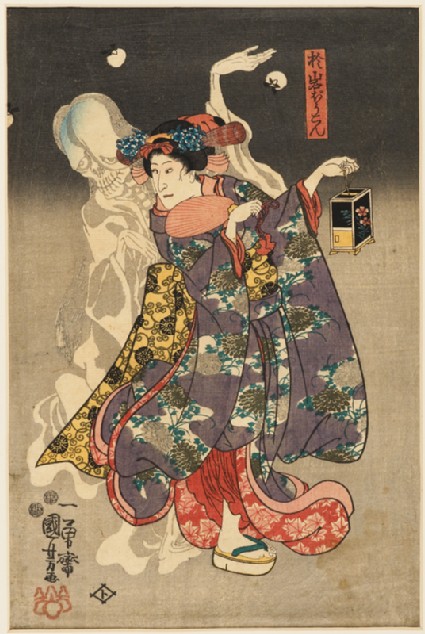Japanese Ghosts and Demons: Ukiyo-e prints from the Ashmolean
(from 29th Sep 2010 until 27th Feb 2011)Prepare for giant spiders, dancing skeletons, winged goblins, and hordes of ghostly warriors!

The Spirit of Oiwa
-
Description
The ghost depicted here is Oiwa, a woman whose husband is seduced by a rich neighbour and persuaded to poison his wife. The wretched Oiwa dies in agony, hideously disfigured by the poison, and her restless spirit returns to torment her murderous husband. The Tale of Oiwa, with its elements of betrayal, murder and ghostly revenge, was turned into a highly successful kabuki play in 1825. It later became a source of inspiration to a number of ukiyo-e woodblock print artists, including Kuniyoshi.
-
Details
- Associated place
- Date
-
1847 - 1848
Edo Period (1600 - 1868)
- Artist/maker
-
Utagawa Kuniyoshi (1797 - 1861) (designer)
- Associated people
-
Ebiya Rinnosuke (publisher)
- Material and technique
- woodblock print, with bokashi (tonal gradation)
- Dimensions
-
mount 55.4 x 34.2 cm (height x width)
print 36 x 24 cm (height x width)
- Material index
- Technique index
- Object type index
- No. of items
- 1
- Credit line
- Presented by George Grigs, Miss Elizabeth Grigs, and Miss Susan Messer, in memory of Derick Grigs, 1971.
- Accession no.
- EA1971.61
Glossary
ukiyo-e
-
ukiyo-e
Ukiyo-e, or ‘Pictures of the Floating World’, depicted leading courtesans, kabuki actors, and others from the urban pleasure districts, in popular woodblock prints and paintings.
Past Exhibition
see (1)-

Japanese Ghosts and Demons: Ukiyo-e prints from the Ashmolean
(from 29th Sep 2010 until 27th Feb 2011)
Location
-
- currently in research collection
Objects are sometimes moved to a different location. Our object location data is usually updated on a monthly basis. Contact the Jameel Study Centre if you are planning to visit the museum to see a particular object on display, or would like to arrange an appointment to see an object in our reserve collections.
Notice
Objects from past exhibitions may have now returned to our stores or a lender. Click into an individual object record to confirm whether or not an object is currently on display. Our object location data is usually updated on a monthly basis, so please contact the Jameel Study Centre if you are planning to visit the museum to see a particular Eastern Art object.
© 2013 University of Oxford - Ashmolean Museum

